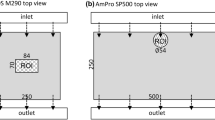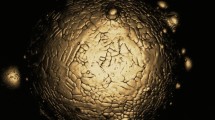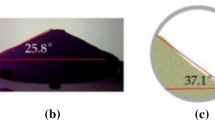Abstract
Laser-directed energy deposition is a fast-growing method for manufacturing complex geometries and materials that are hard to shape with conventional manufacturing methods. However, there are some aspects of this process that need more researches and experiments to be completely understood. Two of these are laser attenuation and laser intensity distribution on the workpiece surface. In this paper, a new method is proposed for calculating laser attenuation without simplification applied in previous works. Despite other studies that consider a predefined powder distribution, the result of a developed 3D CFD model of the powder stream is utilized for defining the position of particles in the powder stream. The divergence and spatial distribution of the laser beam are considered by dividing the laser beam in a radial direction. A GUI has been developed in MATLAB to take CFD model output as input for calculating laser attenuation with Beer-Lambert law and plotting the laser intensity on the workpiece surface after being attenuated. The influence of powder mass flow rate, powder size, and workpiece position on laser attenuation and its intensity distribution is investigated. It is shown that increase in powder flow rate would increase laser attenuation almost linearly. It has also indicated that smaller particles would attenuate more energy than larger ones while the powder mass flow rate is kept constant. More specifically, decreasing powder size from 100 to 20 µ increases attenuation from 18% up to 55%. The size of powder particles affects powder stream distribution, and consequently, this affects the laser intensity profile on the workpiece surface. The result of investigating the workpiece position shows that the position of the workpiece influences the laser attenuation, powder catchment, and maximum intensity of laser energy.
















Similar content being viewed by others
Availability of data and materials
All data generated or analyzed during this study are included in this published article.
References
Moradi M, Hasani A, Pourmand Z, Lawrence J (2021) Direct laser metal deposition additive manufacturing of Inconel 718 superalloy: statistical modelling and optimization by design of experiments. Opt Laser Technol 144:107380
Pinkerton AJ, Li L (2004) Modelling powder concentration distribution from a coaxial deposition nozzle for laser-based rapid tooling. J Manuf Sci Eng 126(1):33–41
Lednev VN, Sdvizhenskii PA, Asyutin RD, Tretyakov RS, Grishin MY, Stavertiy AY, Fedorov AN, Pershin SM (2019) In situ elemental analysis and failures detection during additive manufacturing process utilizing laser induced breakdown spectroscopy. Opt Express 27(4):4612–4628
Martin JH, Yahata BD, Hundley JM, Mayer JA, Schaedler TA, Pollock TM (2017) 3D printing of high-strength aluminium alloys. Nature 549(7672):365–369
DebRoy T, Mukherjee T, Wei H, Elmer J, Milewski J (2021) Metallurgy, mechanistic models and machine learning in metal printing. Nat Rev Mater 6(1):48–68
Khairallah SA, Martin AA, Lee JR, Guss G, Calta NP, Hammons JA, Nielsen MH, Chaput K, Schwalbach E, Shah MN (2020) Controlling interdependent meso-nanosecond dynamics and defect generation in metal 3D printing. Science 368(6491):660–665
Liu D-R, Wang S, Yan W (2020) Grain structure evolution in transition-mode melting in direct energy deposition. Mater Des 194:108919
Liu F, Wei L, Shi S, Wei H (2020) On the varieties of build features during multi-layer laser directed energy deposition. Addit Manuf 36:101491
Wu J, Zhao P, Wei H, Lin Q, Zhang Y (2018) Development of powder distribution model of discontinuous coaxial powder stream in laser direct metal deposition. Powder Technol 340:449–458
Liu C-Y, Lin J (2003) Thermal processes of a powder particle in coaxial laser cladding. Opt Laser Technol 35(2):81–86
Wirth F, Freihse S, Eisenbarth D, Wegener K (2017) Interaction of powder jet and laser beam in blown powder laser deposition processes: measurement and simulation methods. In: Lasers in Manufacturing Conference, Munich, Germany
Lia F, Park J, Tressler J, Martukanitz R (2017) Partitioning of laser energy during directed energy deposition. Addit Manuf 18:31–39
Wang Z, Palmer TA, Beese AM (2016) Effect of processing parameters on microstructure and tensile properties of austenitic stainless steel 304L made by directed energy deposition additive manufacturing. Acta Mater 110:226–235
Huang Y, Khamesee MB, Toyserkani E (2016) A comprehensive analytical model for laser powder-fed additive manufacturing. Addit Manuf 12:90–99
Xiong Y, Smugeresky JE, Schoenung JM (2009) The influence of working distance on laser deposited WC–Co. J Mater Process Technol 209(10):4935–4941
De Oliveira U, Ocelik V, De Hosson JTM (2005) Analysis of coaxial laser cladding processing conditions. Surf Coat Technol 197(2–3):127–136
Kistler NA, Nassar AR, Reutzel EW, Corbin DJ, Beese AM (2017) Effect of directed energy deposition processing parameters on laser deposited Inconel® 718: microstructure, fusion zone morphology, and hardness. J Laser Appl 29(2):022005
Han L, Phatak K, Liou F (2004) Modeling of laser cladding with powder injection. Metall Mater Trans 35(6):1139–1150
Balu P, Leggett P, Kovacevic R (2012) Parametric study on a coaxial multi-material powder flow in laser-based powder deposition process. J Mater Process Technol 212(7):1598–1610
Thompson SM, Bian L, Shamsaei N, Yadollahi A (2015) An overview of direct Laser deposition for additive manufacturing; part I: transport phenomena, modeling and diagnostics. Addit Manuf 8:36–62
Lin J (2000) Laser attenuation of the focused powder streams in coaxial laser cladding. J Laser Appl 12(1):28–33
Guan X, Zhao YF (2020) Numerical modeling of coaxial powder stream in laser-powder-based directed energy deposition process. Addit Manuf 34:101226
Tamanna N, Crouch R, Naher S (2019) Progress in numerical simulation of the laser cladding process. Opt Lasers Eng 122:151–163
Zhang Z, Ge P, Li T, Lindgren L-E, Liu W, Zhao G, Guo X (2020) Electromagnetic wave-based analysis of laser–particle interactions in directed energy deposition additive manufacturing. Addit Manuf 34:101284
Liu Z, Zhang H-C, Peng S, Kim H, Du D, Cong W (2019) Analytical modeling and experimental validation of powder stream distribution during direct energy deposition. Addit Manuf 30:100848
Yao X, Li J, Wang Y, Gao X, Li T, Zhang Z (2021) Experimental and numerical studies of nozzle effect on powder flow behaviors in directed energy deposition additive manufacturing. Int J Mech Sci 210:106740
Kovalev O, Kovaleva I, Smurov IY (2017) Numerical investigation of gas-disperse jet flows created by coaxial nozzles during the laser direct material deposition. J Mater Process Technol 249:118–127
Diniz Neto O, Vilar R (2002) Physical–computational model to describe the interaction between a laser beam and a powder jet in laser surface processing. J Laser Appl 14(1):46–51
Diniz Neto O, Alcalde A, Vilar R (2007) Interaction of a focused laser beam and a coaxial powder jet in laser surface processing. J Laser Appl 19(2):84–88
Pinkerton AJ (2007) An analytical model of beam attenuation and powder heating during coaxial laser direct metal deposition. J Phys D Appl Phys 40(23):7323
Tabernero I, Lamikiz A, Martinez S, Ukar E, De Lacalle LL (2012) Modelling of energy attenuation due to powder flow-laser beam interaction during laser cladding process. J Mater Process Technol 212(2):516–522
Jiazhu W, Liu T, Chen H, Li F, Wei H, Zhang Y (2019) Simulation of laser attenuation and heat transport during direct metal deposition considering beam profile. J Mater Process Technol 270:92–105
Devesse W, De Baere D, Guillaume P (2015) Modeling of laser beam and powder flow interaction in laser cladding using ray-tracing. J Laser Appl 27(S2):S29208
Li W, Zhang J, Karnati S, Zhang Y, Liou F, Newkirk J, Brown Taminger KM (2016) Modeling and experimental investigation of pre-mixed multi-powder flow in fabricating functional gradient material by laser metal deposition process. In: Proceedings of the 27th Solid Freeform Fabrication Symposium (2016, Austin, TX)
Zekovic S, Dwivedi R, Kovacevic R (2007) Numerical simulation and experimental investigation of gas–powder flow from radially symmetrical nozzles in laser-based direct metal deposition. Int J Mach Tools Manuf 47(1):112–123
Morville S, Carin M, Carron D, Le Masson P, Gharbi M, Peyre P, Fabbro R (2012) Numerical modeling of powder flow during coaxial laser direct metal deposition–comparison between Ti-6Al-4V alloy and stainless steel 316L. In: Proceedings of the 2012 COMSOL Conference, Milan
Li W, Zhang X, Liou F (2018) Modeling analysis of argon gas flow rate’s effect on pre-mixed powder separation in laser metal deposition process and experimental validation. Int J Adv Manuf Technol 1–11
Moradi M, Ashoori A, Hasani A (2020) Additive manufacturing of stellite 6 superalloy by direct laser metal deposition–part 1: effects of laser power and focal plane position. Opt Laser Technol 131:106328
Moradi M, Hasani A, Beiranvand ZM, Ashoori A (2020) Additive manufacturing of stellite 6 superalloy by direct laser metal deposition–part 2: effects of scanning pattern and laser power reduction in differrent layers. Opt Laser Technol 131:106455
Frenk A, Vandyoussefi M, Wagniere J-D, Kurz W, Zryd A (1997) Analysis of the laser-cladding process for stellite on steel. Metall Mater Trans B 28(3):501–508
Wen S, Shin Y, Murthy J, Sojka P (2009) Modeling of coaxial powder flow for the laser direct deposition process. Int J Heat Mass Transf 52(25–26):5867–5877
Haley JC, Zheng B, Bertoli US, Dupuy AD, Schoenung JM, Lavernia EJ (2019) Working distance passive stability in laser directed energy deposition additive manufacturing. Mater Des 161:86–94
Author information
Authors and Affiliations
Contributions
Niloufar Sobhanieh: conceptualization, methodology, resources, writing—original draft (first author). Javad Akbari: supervision and editing (corresponding author). Mahmoud Moradi: supervision and editing.
Corresponding author
Ethics declarations
Ethical approval
Our paper is an original paper which has neither previously, nor simultaneously, in whole or in part been submitted anywhere else. All authors prove that the paper is an original paper.
Consent to participate
The authors agreed to participate in this manuscript.
Consent for publication
The authors agreed with this submission.
Competing interests
The authors declare no competing interests.
Additional information
Publisher's Note
Springer Nature remains neutral with regard to jurisdictional claims in published maps and institutional affiliations.
Rights and permissions
About this article
Cite this article
Sobhanieh, N., Akbari, J. & Moradi, M. A new method for calculating laser intensity distribution on workpiece surface in laser-directed energy deposition process by considering powder stream distribution and laser attenuation. Int J Adv Manuf Technol 121, 337–348 (2022). https://doi.org/10.1007/s00170-022-09301-1
Received:
Accepted:
Published:
Issue Date:
DOI: https://doi.org/10.1007/s00170-022-09301-1




